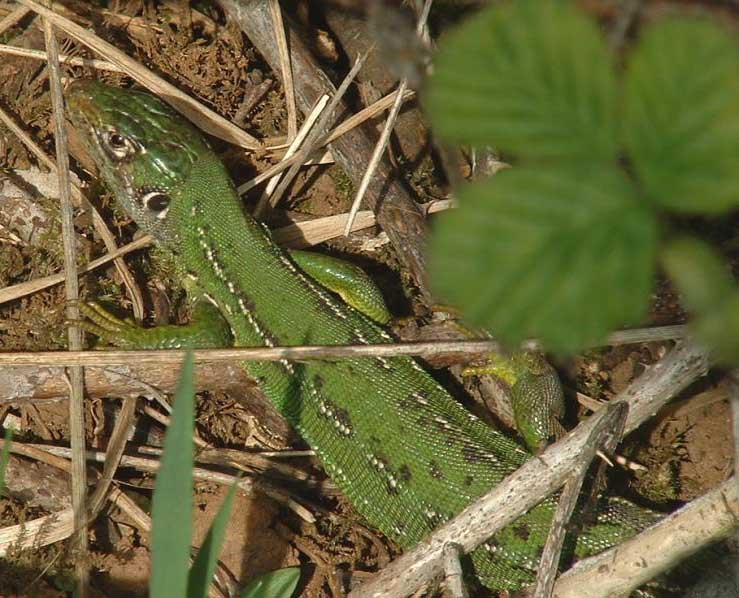
Lacerta bilineata (*)
Superregnum: Eukaryota
Cladus: Unikonta
Cladus: Opisthokonta
Cladus: Holozoa
Regnum: Animalia
Subregnum: Eumetazoa
Cladus: Bilateria
Cladus: Nephrozoa
Superphylum: Deuterostomia
Phylum: Chordata
Subphylum: Vertebrata
Infraphylum: Gnathostomata
Megaclassis: Osteichthyes
Cladus: Sarcopterygii
Cladus: Rhipidistia
Cladus: Tetrapodomorpha
Cladus: Eotetrapodiformes
Cladus: Elpistostegalia
Superclassis: Tetrapoda
Cladus: Reptiliomorpha
Cladus: Amniota
Classis: Reptilia
Cladus: Eureptilia
Cladus: Romeriida
Subclassis: Diapsida
Cladus: Sauria
Infraclassis: Lepidosauromorpha
Superordo: Lepidosauria
Ordo: Squamata
Cladus: Unidentata Episquamata
Subordo: Lacertoidea
Infraordo: Lacertibaenia
Familia: Lacertidae
Subfamilia: Lacertinae
Genus: Lacerta
Species: Lacerta bilineata
Subspecies (3): L. b. bilineata – L. b. chloronota – L. b. indet
Name
Lacerta bilineata Daudin, 1802: 152
Type locality: “environs de Paris”, France.
References
Primary references
Daudin, F.M. 1802. Histoire naturelle, générale et particulière, des reptiles : ouvrage faisant suite à l'Histoire naturelle générale et particulière, composée par Leclerc de Buffon, et rédigée par C.S. Sonnini. Tome Troisième. L'Imprimerie de F. Dufart: Paris. 452 pp. + pls. XXVI–XLV. BHL Reference page.
Links
Uetz, P. & Hallermann, J. 2022. Lacerta bilineata. The Reptile Database. Accessed on 1 August 2018.
Pérez-Mellado, V., Cheylan, M., Geniez, P., Nettmann, H.K., Schmidt, B., Podloucky, R., Sindaco, R. & Romano, A. 2009. IUCN: Lacerta bilineata (Least Concern). The IUCN Red List of Threatened Species 2009: e.T61519A12501065. DOI: 10.2305/IUCN.UK.2009.RLTS.T61519A12501065.en
Vernacular names
català: Lluert
Deutsch: Westliche Smaragdeidechse
English: Western Green Lizard
español: Lagarto verde occidental
euskara: musker berdea
français: Lézard à deux bandes
italiano: Ramarro occidentale
Nederlands: Westelijke smaragdhagedis
vèneto: Ligaor
The western green lizard (Lacerta bilineata) is a lizard of the family Lacertidae.
Etymology
The genus name Lacerta and the species name bilineata are Latin words respectively meaning “lizard” and “with two lines”, with reference to the pale lines present on the flanks of the young individuals.
Subspecies
Lacerta bilineata bilineata Daudin, 1802 (in Spain, France, Switzerland and Germany) [2]
Lacerta bilineata chloronota Rafinesque-Schmaltz, 1810 (in southern Italy and Sicily)
Lacerta bilineata chlorosecunda Taddei, 1950 (in southeastern Italy)
Lacerta bilineata fejervaryi Vasvary, 1926 (in Italy from Tuscany up to Naples)
Distribution
It is native in Andorra, Croatia, France, Germany, Italy, Monaco, Serbia, Slovenia, Spain, Switzerland, Guernsey and Jersey in the Channel Isles. and introduced into the United States. There are also introduced colonies on the south coast of the U.K, notably around Poole Bay in Dorset.
Description
Lacerta bilineata reaches an average length (excluding tail) of about 13 centimetres (5.1 in), with a maximum of 40 centimetres (16 in), including tail. The tail may reach up to twice the body length. The average weight is about 35 grams. The body is bright green. The head is bigger in males than in females, and the males often show a blue throat. Juveniles are almost brown, with a yellowish belly and two to four pale, longitudinal lines along the flanks. Sub-adults also have these lines, together with several small brown spots on their backs.[3]
These lizards are territorial animals. They feed on arthropods, mainly large insects. They attain sexual maturity at around two years, when they are about 8 cm long (excluding tail). The males fight each other, especially during the mating period, when they are very aggressive towards rivals. The mating ritual is precise, and starts with a bite to the base of the female's tail. The females lay 6 to 25 eggs in a humid and warm site, such as in a decomposing log. The average life span of this species is about 15 years.[3]
Habitat
Its natural habitats are green humid areas, temperate forest, the edges of woods, shrubland, open grassland, arable land, and pastureland. It is threatened by habitat loss.
References
Valentin Pérez-Mellado, Marc Cheylan, Philippe Geniez, Hans Konrad Nettmann, Benedikt Schmidt, Richard Podloucky, Roberto Sindaco, Antonio Romano (2009). "Lacerta bilineata". IUCN Red List of Threatened Species. 2009: e.T61519A12501065. doi:10.2305/IUCN.UK.2009.RLTS.T61519A12501065.en. Retrieved 17 November 2021.
Biolib
Reptiles & Amphibiens de France
List of reptiles of Italy
Retrieved from "http://en.wikipedia.org/"
All text is available under the terms of the GNU Free Documentation License

